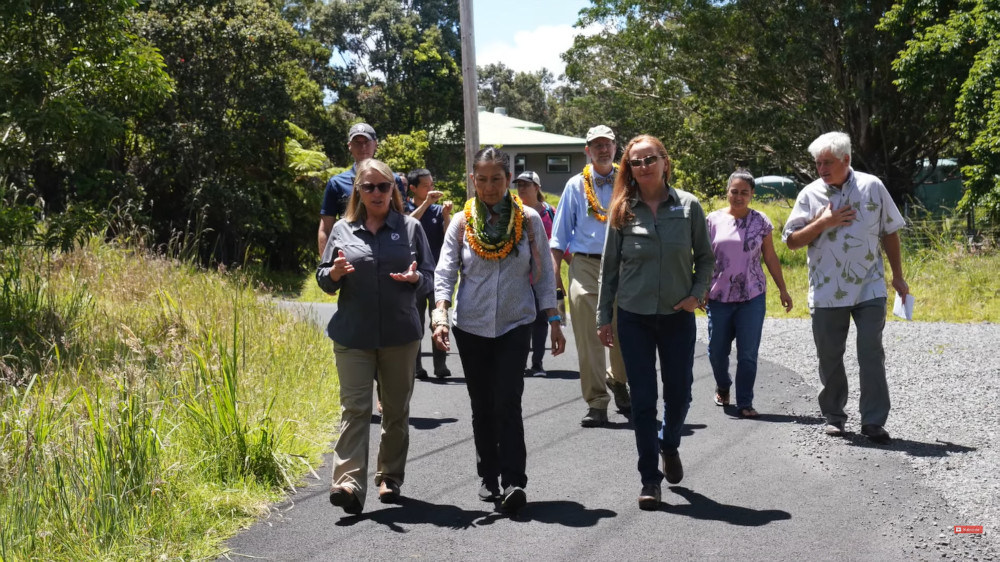This Week at Interior June 30, 2023
(BIVN) – The recent, week-long trip to Hawaiʻi by Secretary of the Interior Deb Haaland – including a visit to different areas of the Big Island – has been summarized in the the latest This Week at Interior video (above), and this more detailed news release:
KONA, Hawaiʻi – Secretary of the Interior Deb Haaland wrapped up a week-long trip to Hawaiʻi, where she highlighted how President Biden’s Investing in America agenda and “Bidenomics” strategy are helping to protect iconic Hawaiian bird species, strengthen the Native Hawaiian Community, and invest in the science and infrastructure that support our public lands and waters.
Throughout the visit, Secretary Haaland, Assistant Secretary for Fish and Wildlife and Parks Shannon Estenoz, and Senior Advisor for Native Hawaiian Affairs Summer Sylva met with federal, state and local leaders, members of the Native Hawaiian Community and Department personnel at various sites and public lands throughout the Hawaiian Islands. They also visited sites that help tell a more honest, inclusive, and complicated story of America’s history, including Pearl Harbor National Memorial and ʻIolani Palace, which recently received nearly $500,000 for restoration through a Save America’s Treasures Grant from the National Park Service.
Protecting and Conserving Iconic Hawaiian Species
During the trip, Secretary Haaland announced that the Department has committed nearly $16 million as part of President Biden’s Investing in America agenda to prevent the imminent extinction of Hawaiian Forest Birds. The funding will support a new Hawaiian Forest Bird Conservation Keystone Initiative, which was unveiled as part of the Department’s Restoration and Resilience Framework. The Framework is guiding $2 billion in investments from the Bipartisan Infrastructure Law and Inflation Reduction Act to restore lands and waters and advance climate resilience. The announcement was made during the Secretary’s remarks at the Hawaiʻi Conservation Conference, which included a moving oli kāhea (call) in tribute to Hawaiian Forest Birds.Secretary Haaland and the team visited with staff from Hakalau Forest National Wildlife Refuge and toured Keauhou Bird Conservation Center to see firsthand Hawaiian Forest Birds in their habitats and get briefed on ongoing conservation and restoration efforts already underway due to the new influx of funding and existing network of place-based and culturally informed partnerships. She heard from U.S. Fish and Wildlife Service staff about new efforts to improve the conservation and recovery of imperiled Endangered Species Act-listed species.
Engaging with the Native Hawaiian Community
Throughout the visit, Secretary Haaland highlighted the Department’s commitment to work with Indigenous communities to protect our lands and waters, revitalize Indigenous languages, and acknowledge and address the enduring legacy of assimilationist policies.While on Oʻahu, the Secretary and Senator Brian Schatz lifted up the Department’s work to advance co-stewardship opportunities with Indigenous communities by touring three Native Hawaiian Community-led efforts located within the Heʻeia Koʻolaupoko watershed. Each of these efforts are advancing cultural and environmental restoration by embracing traditional Native Hawaiian cultural and land-management practices within a modern day ahupua’a (land division).
In 2021, the Department issued a Secretary’s Order to advance a policy of co-stewardship of federal lands and waters with Tribes as well as the Native Hawaiian Community. Already, the Biden-Harris administration has signed 20 agreements, with more than 50 others in the works.
As part of the Department’s work to hear directly from survivors and their descendants through the Federal Indian Boarding School Initiative, Secretary Haaland met with survivors and descendants to learn how federal assimilation policies impacted the Native Hawaiian Community. During the meeting, she heard how the overthrow of the Hawaiian monarchy and subsequent prohibitions on the use of ʻŌlelo Hawai’i (the Hawaiian language) throughout the 20th century left intergenerational impacts that still persist.
The Secretary also visited two Native Hawaiian language campuses in Kea’au and Hilo, where she met with students and faculty to hear how ʻŌlelo Hawai’i immersion programs and efforts have led the way in restoring and revitalizing Indigenous languages, cultural practices, and worldviews in Hawaiʻi and across the continent. Advancing Native language efforts and investments has been at the forefront of the Department’s policy initiatives. The Department is also supporting the Native Hawaiian Community through funding from the NATIVE Act, which promotes Indigenous heritage and cultural tourism opportunities that advance the socio-economic empowerment of Native American, Alaska Native and Native Hawaiian communities.
Enhancing Science and Infrastructure to Support Public Lands and Waters
In Hilo, Secretary Haaland, Senator Schatz, and U.S. Geological Survey Director David Applegate participated in a ground blessing ceremony for a new facility that will house two USGS science centers: the Hawaiian Volcano Observatory and the Pacific Island Ecosystems Research Center. The USGS leads on volcano monitoring and eruption response, hazards communication, and advancing science critical to addressing natural-resource challenges in Hawaiʻi.Secretary Haaland and the team also toured Hawaiʻi Volcanoes National Park, Pu‘uhonua o Hōnaunau National Historical Park and Kaloko-Honokōhau National Historical Park to meet with Department staff and community partners to discuss climate change impacts in the parks and how investments from the President’s Investing in America agenda are supporting infrastructure improvements and visitor experience. At Kaloko, she walked a section of the Ala Kahakai National Historic Trail, which traverses wahi pana (storied landscapes), ancient Hawaiian sites and over 200 ahupuaʻa (traditional land divisions).


by Big Island Video News7:06 am
on at
STORY SUMMARY
WASHINGTON - Secretary of the Interior Deb Haaland just wrapped up a week-long trip to Hawaiʻi, which included a visit to the Big Island.